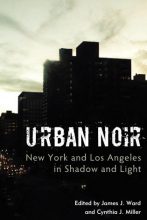Both Los Angeles and New York City have been of particular interest to movie producers, especially to those who shot drama that was later called film noir. The authors want to dig deeper to unearth the reasons for those two locations, since the ”… inescapable question, then, is: Why this animosity toward the two cities that, historically as well as socially, economically, and culturally, are seen as encapsulating America’s urban experience as well as forecasting its future?“
 Nevertheless, both cities have been destroyed in fiction and movies several times; L.A. has been wiped out more than 130 times, either in parts or entirely. (The destruction of New York in fiction and movies alone is the theme of two volumes of research.)
Nevertheless, both cities have been destroyed in fiction and movies several times; L.A. has been wiped out more than 130 times, either in parts or entirely. (The destruction of New York in fiction and movies alone is the theme of two volumes of research.)
So Urban Noir aims to uncover the fascination of millions of readers and cinema audiences who long to read about or witness the destruction of the two cities in film; however, both big cities actually do have a dark and evil air about them, some may say.
Even as they seem to represent the opposite of one another – one sun-drenched, the other one dark, as streets in Manhattan hardly ever get enough sunlight due to the height of its buildings – both, in fiction and real life, signify crime, corruption, violence and murder.
The editors, James J. Ward and Cynthia J. Miller were motivated by latest developments in film noir research. As the style/genre (luckily) is one of the most discussed and best researched themes in film history, recent publications strongly take into account the city as unique geographical spot. This means that by now the idea of the city as location, visual motif or integral part of drama is not satisfying anymore.
Instead, as it is the editor’s intention, the characteristics of the (nighttime) city must be examined carefully, that is the specific streets, neighborhoods, extra diegetic detail such as urban geography, sounds connected to it, city planning or (contemporary) communication networks.
Needless to say that in what the editors here identify as “mainstream film noir scholarship,” the city exists as a vague, stereotypical and mythical place, devoid of detailed and incomparable character.
But this quality is what the two cities in focus here possess, explain the editors. And this becomes even more obvious when we realize that about half of all films noir are set in either L.A. or New York. Several neo-noirs also were shot there (SE7EN, 8MM, and others). So the 12 essays collected here explore the “when” and “where” of films noir from different decades, which is not the standard procedure either, since in film noir research, the majority of academic texts distinctly divides the genre (among other criteria) still into (original) film noir and neo-noir. The essays thus in a way make up for the strange neglect of each city’s ‘mistreatment’ in film noir research so far.
The selection focuses on very different themes, many of them, however, have been barley touched subjects in research: the aural/audio background while exploring the city at night by car and having the police radio produce the city’s soundtrack, extradiegetic sounds, narration and voice-over, or the organization of space as related to the character’s movement within the city. Moreover, topics such as Jean-Pierre Melville’s protagonists as representatives of ‘the other’ in his two films noir set in New York, Jaques Deray’s The Outside Man and the film’s use of L.A. spaces, Harlem’s changing image in crime movie/film noir history and black detectives in both cities (Dead Presidents and Devil in A Blue Dress), neo-noir splatter films, urban drama as related to lack of community in 1940’s noirs and finally there are the ‘yuppie-angst’ movies of the 1980s and representations of a dark and unsafe New York of the 1970s.
Urban Noir is very refreshing and highlights new perspectives on the roles of the big city in movies. The essays ‘shed light’ on the many dark places in those L.A. and New York films and considering the small number of books devoted to the metropolis, the title will be of great interest to movie historians, scholars of urban living and (possibly) architects, too. Notably, the texts on the aural nature of many noirs are worth reading, as sound in many films is usually neglected in many studies. (This does exclude soundtracks and non-diegetic music, where there are several texts available).
Review by Dr. A. Ebert © 2018
James J. Ward and Cynthia J. Miller (eds.) Urban Noir: New York and Los Angeles in Shadow and Light. Rowman & Littlefield, 2017, 254 p.
